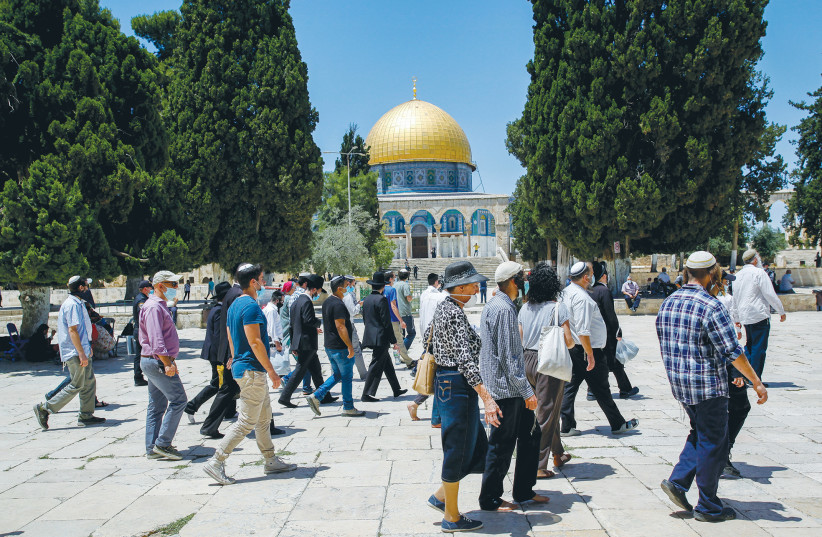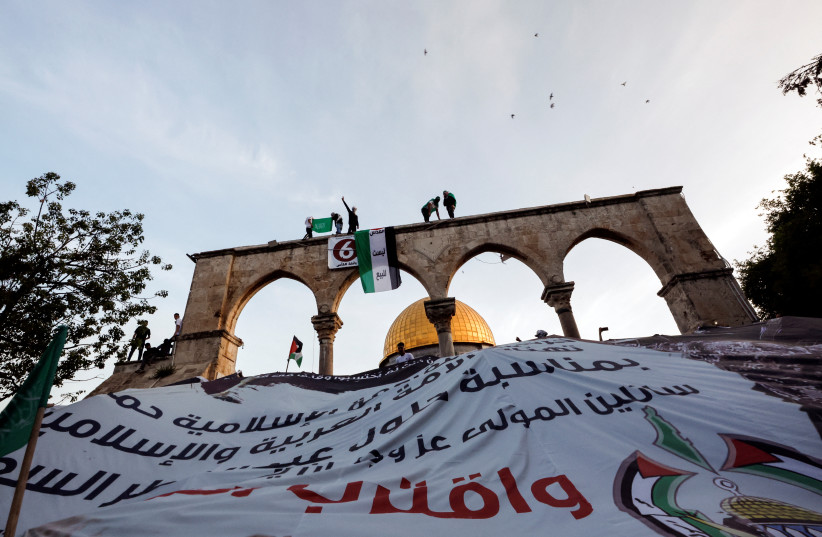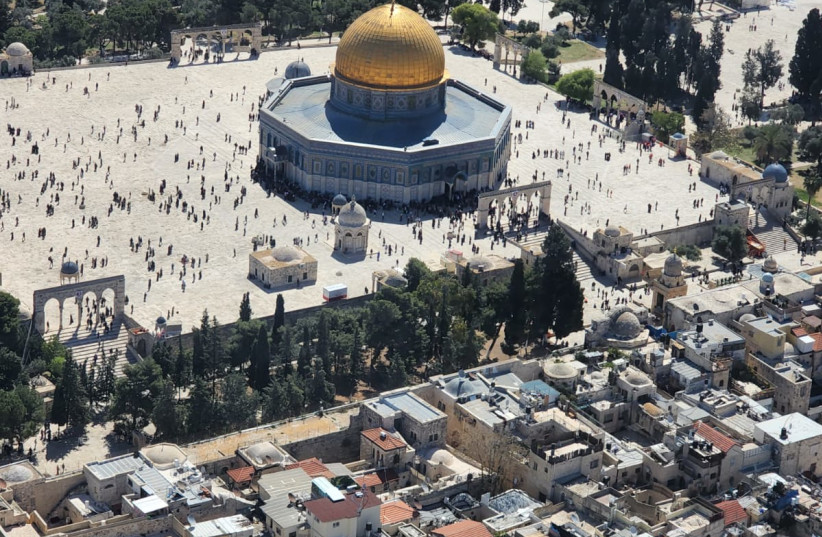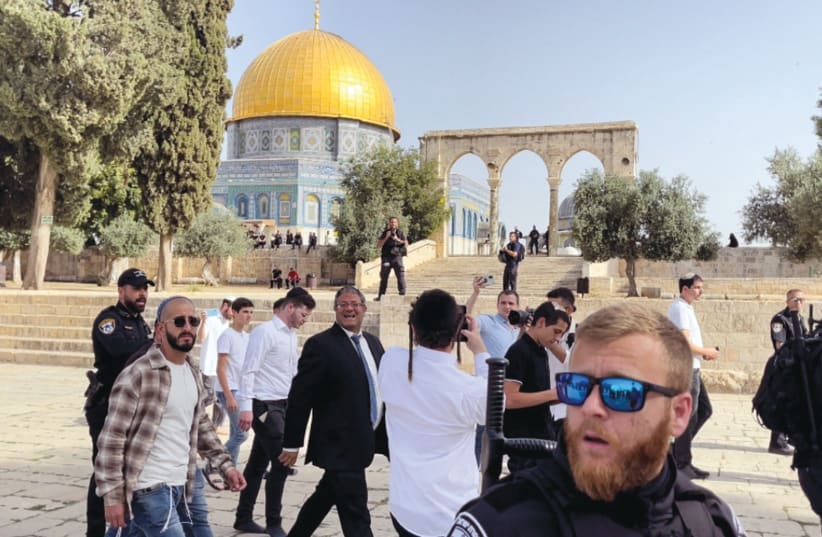As preparations accelerate for the establishment of a new Israeli government, many eyes in Israel, the region and the world are turned to the Temple Mount. This religiously sensitive site with its explosive potential appears to pose a major test for the new government and warning sirens are being sounded even before the government has been formed. Tensions at the Temple Mount have served as a catalyst for repeated violent clashes in the Israeli-Palestinian arena over the years, including confrontations in 2014, 2015, 2017 and 2021 in just the past decade.
Previous escalations forced Netanyahu to conduct a diplomatic dialogue with Jordan and agree on arrangements emphasizing his commitment to the status quo, as well as restrictions on visits by Knesset members or Temple Mount activists (i.e. the 2015 Kerry understandings). But the balance in the emerging government coalition has shifted, with the members of the Religious Zionist bloc that advocate significant change in the status quo having greater influence and Netanyahu being more dependent on them, thus having limited room for maneuver.
Growing tension
Against this backdrop, Jordanian officials have been warning that an attempt by the new government to change the status quo at the site and allow provocative actions by Ben-Gvir as a future minister of national security, could threaten peaceful relations with Jordan and inflame the entire region. Netanyahu had reportedly sent reassuring messages to Jordan but this is unlikely to allay the serious concerns over the issue.
In view of the growing tension over this issue, and based on the long history of escalation and violent eruptions at the site, it is incumbent on all relevant actors to increase coordination and institutionalize communications channels to forestall crises. The recently published annual Mitvim Foreign Policy Index found that 61% of the Israeli public (including a majority of center-right voters) support the idea of establishing a coordination mechanism among Israel, Jordan and the Palestinians to prevent escalation at Jerusalem’s holy sites.
Only 20% objected, reflecting the Israeli public’s awareness of the issue’s sensitivity and of the need to strengthen coordination and dialogue among the parties involved.


After the Six Day War in 1967, a secret channel of communication was established between Israeli authorities and the Wakf administration under Jordanian auspices, which is tasked with the management of the Temple Mount site, and a modus vivendi was developed between the parties. Professor Yitzhak Reiter demonstrated in his research on the Temple Mount that the coordination mechanism and the quiet understandings formed between the sides collapsed following the 1996 Western Wall Tunnel affair and the severe rift following the second intifada and the escalation at the site.
Under Netanyahu’s rule, tensions with Jordan deepened and the contacts with the Wakf weakened. The rounds of violence during this period led to American involvement in a bid to fill the vacuum and end the crises. This was the case, for example, in November 2014 and October 2015, when then-secretary of state John Kerry shuttled between Jerusalem, Amman, and Ramallah, and formulated understandings to ease tensions.
Over the past year, the Bennett-Lapid government attempted to preempt escalation during Ramadan through intensive Israeli-initiated contacts with Jordan and the Palestinians, which included meetings between Yair Lapid, Benny Gantz, and Omer Bar Lev with senior Jordanian and Palestinian officials. This move was led by the parties, rather than by an external actor, and was made possible by the improved relations with Jordan and the PA, reflecting a desire to act before and not after escalation.
A model for a permanent framework
But the idea examined in the Mitvim survey suggests a different model. Instead of efforts by external parties to douse the flames after the fire has already broken out or ad hoc contacts between senior officials to ease the crisis, the model proposes a permanent framework of dialogue, coordination and cooperation on this most sensitive and volatile issue.
SUCH A mechanism would enable a constant channel of communications, serve as a tool for message and information exchanges and confidence building measures, promoting coordination and preparations for times of crisis, and agreed moves to calm tensions and restore order.
Public support for the idea shows that Israelis understand the special sensitivity of the Temple Mount and the need for coordination with other parties, and recognizes their role in managing the site, especially given the risks of escalation and loss of control. Such a step is, of course, politically sensitive and will likely be opposed by those seeking to change the status quo but the majority of the public appears to support it.
If this policy direction is agreed upon, the sides will be required to discuss the nature of the mechanism, the parties involved and its mandate. The mechanism must include those involved in the daily running and protection of the site, who are well acquainted with the ins and outs of the situation, as well as political representatives acting in coordination with the decision makers to ensure a civil-political dimension and not just a security one.


Mechanisms to prevent escalation are urgently needed
The parties will also be able to discuss the integration of other actors, including a possible dialogue with religious leaders and community representatives. The Geneva Initiative of 2003 proposed the establishment of an interfaith council to serve as an advisory body on the management of the holy sites.
At the same time, the participation of additional players at the regional or international level is also important. These players could include Morocco, which chairs the Jerusalem Committee of the Organization of Islamic Cooperation, and Saudi Arabia, which bears responsibility for Islam’s holy sites in Mecca and Medina.
Similar proposals and ideas have arisen over the years regarding the establishment of special mechanisms for the management of the holy sites. Then-prime minister Olmert’s proposal in 2008, for example, included a framework consisting of five states: Israel, Palestine, Jordan, Saudi Arabia and the US. The Amirav-Husseini plan (2000) proposed a composition of 11 states, including Israel, Palestine the five permanent members of the UN Security Council and four Arab states.
The Oslo process chose to postpone the question of Jerusalem’s future to the final stage of negotiations, consistent with Israel’s desire to delay discussion of the issue as much as possible. But the periodic tensions that erupt in Jerusalem make it clear time and again that the issue cannot be ignored.
Therefore, the construction of mechanisms to prevent escalation in Jerusalem should be an immediate and urgent move, not the end of the road. Moreover, a mechanism regarding the holy sites could also be a first step in laying the ground for cooperation on other issues, and perhaps even the start of political momentum in the future and the beginning of a real dialogue on the question of Jerusalem.


The combination of recent and increasing instability in the West Bank, the tensions in eastern Jerusalem and the fears of extreme and dangerous policies promoted by some members of the new government create a particularly volatile mix and any unusual incident on the Temple Mount could trigger a flare-up.
This state of play underscores the critical importance of preventing escalation at this sensitive site and instituting permanent and effective coordination and dialogue mechanisms between all parties involved.
The writer is the director of the Israeli-Palestinian Peacemaking Program at Mitvim Institute.
